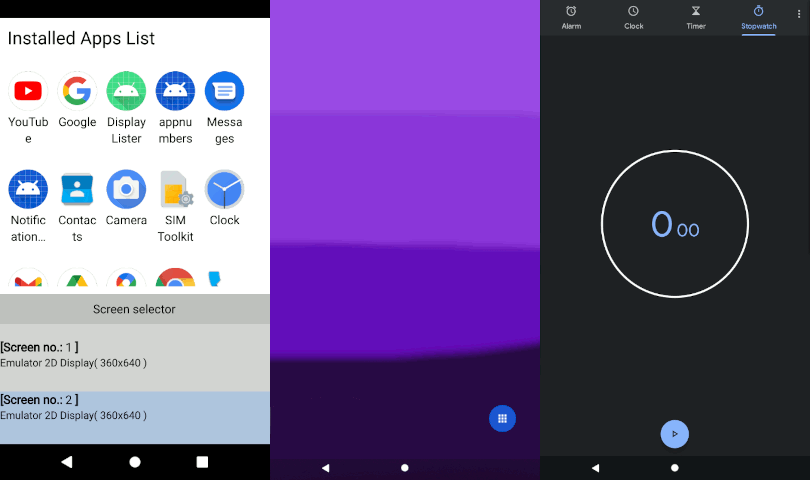C
多屏启动器
演示了使用具有多屏支持的 Qt Android Apps Utils API 的用法。

本例演示了如何使用 Qt Android Automotive Base 在 Android 或 Android Automotive 设备上显示已安装应用程序的列表,并如何在所选屏幕上运行特定应用程序。应用程序用户界面是通过使用 Qt Quick 创建的。
在启动应用程序时,除系统应用程序外,显示所有已安装应用程序的列表,如下所示:GridView。按下图标即可启动应用程序。在应用程序网格下方是可用屏幕的列表。所选应用程序将运行在列表中选定的屏幕上。
运行示例
要从 Qt Creator 中运行示例,打开 欢迎 模式并从 示例 中选择示例。有关更多信息,请参阅 Qt Creator:教程:构建和运行。
使用模型
已安装应用程序模型基于 C++ 中的 QAbstractListModel,并将其扩展到 QML。该模型可以像在 App Lister 示例中一样,在需要时与 ListView 或 GridView 一起使用。
在示例中,使用了 ListView 来显示可用的屏幕。模型如下附加到屏幕列表中
ListView { id: screensListView anchors.left: parent.left anchors.right: parent.right anchors.bottom: parent.bottom height: 200 model: Application.screens
现在,我们将列表的代理设置为显示可用屏幕信息,并选择首选屏幕。所选屏幕将作为运行应用程序的目标。
id: screenItemDelegate Rectangle { id: screenItemRectangle required property QtObject modelData required property int index color: ListView.isCurrentItem ? "lightsteelblue" : "lightgrey" width: window.width height: 80 - window.marginSize Column { Text { id: screenItemIdLabel font.pointSize: 16 text: "<b>[Screen no.:</b> " + screenItemRectangle.index + " <b>]</b>" horizontalAlignment: Text.AlignLeft maximumLineCount: 1 } Text { id: screenItemNameLabel font.pointSize: 14 text: screenItemRectangle.modelData.name + "( " + screenItemRectangle.modelData.width + "x" + screenItemRectangle.modelData.height + " )" } } MouseArea { id: screenItemArea anchors.fill: parent onClicked: { screensListView.currentIndex = screenItemRectangle.index } } } }
使用 API 调用
在 ListView 代理内部,我们可以访问来自 Android Apps Utils 的一些信息,并使用它们来启动应用程序,例如
AndroidAppsUtils.startAppOnScreen(delegate.model.packageName, screen) } } } Text { id: appName text: delegate.model.appName width: delegate.width anchors.top: appIcon.bottom anchors.topMargin: window.marginSize / 3 horizontalAlignment: Text.AlignHCenter elide: Text.ElideRight wrapMode: Text.Wrap maximumLineCount: 2 } } } ListView { id: screensListView anchors.left: parent.left anchors.right: parent.right anchors.bottom: parent.bottom height: 200 model: Application.screens headerPositioning: ListView.OverlayHeader header: screensListHeader delegate: screenItemDelegate focus: true clip: true } Component { id: screensListHeader Rectangle { z: 2 width: window.width height: 40 visible: true color: "silver" Text { anchors.centerIn: parent text: qsTr("Screen selector") } } } Component { id: screenItemDelegate Rectangle { id: screenItemRectangle required property QtObject modelData required property int index color: ListView.isCurrentItem ? "lightsteelblue" : "lightgrey" width: window.width height: 80 - window.marginSize Column { Text { id: screenItemIdLabel font.pointSize: 16 text: "<b>[Screen no.:</b> " + screenItemRectangle.index + " <b>]</b>" horizontalAlignment: Text.AlignLeft maximumLineCount: 1 } Text { id: screenItemNameLabel font.pointSize: 14 text: screenItemRectangle.modelData.name + "( " + screenItemRectangle.modelData.width + "x" + screenItemRectangle.modelData.height + " )" } } MouseArea { id: screenItemArea anchors.fill: parent onClicked: { screensListView.currentIndex = screenItemRectangle.index
另请参阅 Qt for Android。
在特定的 Qt 许可证下提供。
了解更多信息。
